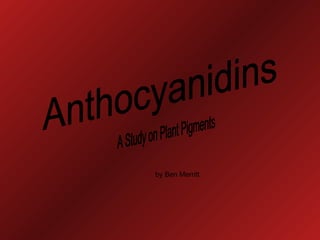
anthocyanin
- 2. What are Anthocyanidins? • From the Greek antos: flower ; kyanos: blue • They are a class of pigments belonging to a larger group known as flavonoids, coming from a simple C6 – C3 – C6 structure of carbon rings. • Have been used since antiquity as dyes, contributing to the coloration of petals, fruits, bracts and leaves.
- 3. Where can they be found? • They can be found in a variety of places in plants, depending on their specific role. • Often they appear in quite attractive colors, so they will oftentimes exist in flowers and berries, such as in grapes and wines, and cranberries.
- 4. Where can they be found? • Yet, for the purposes of this project, I will only be considering anthocyanidins in leaves. • They are often found in young, developing leaves as a sort of sun screen.
- 5. Synthesis • Produced in response to light, whether it be visible, UV. • Production results from two synthesis pathways: acetate and shikimic acid. • Acetate pathway produces 3 malonyl coenzyme A (CoA). • The shikimic acid pathway produces phenylalanine. • The two pathways combine to produce the base molecule, the naringenin chalcone.
- 6. Structure • Consists of three carbon rings. • What distinguishes anthocyanidins from anthocyanins is the presence of sugars, generally at the C-3 position (glycosides). • Sugars can include glucose, arabinose, rhamnose, and galactose. • Degree of hydroxylation or methoxylation on the B ring. More OCH3 = red, more OH = blue. • Electron deficiency - particularly reactive towards electron-lusting reactive oxygen species (ROS). General structure of anthocyanins
- 7. Structure • Around 12 anthocyanidins. Most common in leaves is cyanindin. • Names of compounds generally reflect species from which they were first obtained. • Thus pelargonidin is from Pelargonium, or geranium. It often exists in pink, scarlet, and orange-red flowers. • Delphinidin was named after Delphinium, and generally mauve or blue flowers have this compound.
- 8. How are free radicals dangerous? • Incredibly unstable atoms or molecules with an unpaired electron. • Ionizing radiation • “Chain-reaction” problem. • Often tear apart molecules. Can cause various mutagenic- related effects, esp. on DNA. • Chain reaction ends when 2 radicals meet each other and each contributes its unpaired electron. This is why anthocyanins are so important.
- 9. Chemistry • Effectively absorb UV-B light. • UV radiation is generally dangerous; produces free radicals. • Keep in mind that anthocyanins are also very reactive towards ROS. • Produced in young leaves to directly absorb UV radiation as well as to effectively neutralize free radicals. • More at higher elevations
- 10. Chemistry and pH • Exists around 5-6 common structures. • Structures go through de/protonation, hydration to change structure. • Different colors in different pH. Name Color pH Flavylium Cation Red ≤3 Carbinol Pseudobase Colorless 4-5 Quinoidal Pseudobase Purple / Violet 6-7 Quinoidal Pseudobase Anion Blue 7-8 Chalcone Pseudobas e Yellowish ≥8
- 11. My Own Experimentation • Rose solution Unaltered solution: pH = ~4.1 Added 6M NaOH: pH = ~9.8 6M HCl: pH = ~0.8
- 12. My Own Experimentation • Red cabbage solution pH: ~12.5 ~7 ~5.6 ~2.5 ~11.5
- 13. Chemistry and pH • As stated before, flavylium ion undergoes various structural changes based on pH. • Various tautomeric and other insignificant structures.
- 14. So what? • Sure, these pigments are useful for plants. But why are they of importance to humans? • These pigments are produced exclusively in plants; thus,animals cannot synthesize them. Therefore utilizing them has proven to be beneficial. • Evidence that diseases like cancer, cardiovascular disease are result of oxidative stress. So antioxidants, like anthocyanins, are thoroughly studied. • Exhibit antimutagenic activies and even reduce the occurrence of tumors in rats. • Anticarcinogenic properties in cyanin-rich berries – billberry, cranberry, lingon berry, etc. • Lower incidence of coronary artery disease in Mediterranean thought to be a result of diets rich in antioxidants. Studies with cyanidin show it to be an in vivo inhibitor of LDL cholesterol oxidation.
- 15. So what? Eat More Berries!!!
- 16. Bibliography • Arnett, Ross H., Jr. and George F. Bazinet, Jr. Plant Biology: A Concise Introduction. Forth Ed. Saint Louis: The C.V. Mosby Company, 1977. • Galvano, Fabio, et al. “Anthocyanins and cyanidins: chemistry, analysis, sources and biological properties.” IFIS Publishing, March 18, 2004. <http://www.foodsciencecentral.com/fsc/ix id12880> (February 26, 2010). • Hopkins, William G. Introduction to Plant Physiology. Second Ed. New York: John Wiley and Sons, Inc., 1999. • Keusch, Peter. “Anthocyanins as pH-Indicators and Complexing Agents.” <http://www.chemie.u ni- regensburg.de/Organische_Chemie/Didaktik/Keusch/p26_anth-e.htm> (May 28, 2010). • Kimball, John W. “Reactive Oxygen Species (ROS).” <http://users.rcn.com/jkimball.ma.ultranet/ BiologyPages/R/ROS.html> (February 27, 2010). • Krogh, David. Biology: A Guide to the Natural World. Third Ed. Upper Saddle River: Pearson Prentice Hall, 2005. • Murai, Yoshinori, et al. “Altitudinal variation of UV-absorbing compounds in Plantago asiatica.” Biochemical Systematics and Ecology. July 2009: 378-384. Print. • Sullivan, Jack. “Anthocyanin.” Carnivorous Plant Newsletter, 1998, 27(3):86-88. Web: <http:// www.carnivorousplants.org/cpn/samples/samplemain.htm> (February 26, 2010). • Thorsten, C. “Anthocyanins from Red Cabbage - With Experiments.” <http://www.crscientific.c om/newsletter10-anthocyanins.html> (May 29, 2010).